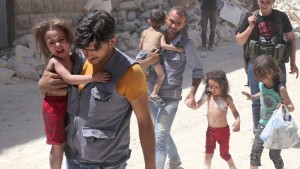Reports of chemical gas attacks in 2 Syrian cities
Two chemical gas attacks have been reported in northern Syria, one in the region where a Russian helicopter was downed a day earlier, killing all five people on board.
In the first alleged attack, cylinders suspected of containing chlorine gas were dropped in residential areas in the city of Saraqeb in Idlib province, the anti-regime, voluntary search-and-rescue group Idlib Civil Defence said in a post on its Facebook page.
Russia, Syria's key military backer, has vehemently denied that a chemical attack took place. In a news release carried by Russian and Syrian state news agencies, Kremlin spokesman Dmitry Peskov said the claims of chlorine usage were fabricated by the media.
The United States is not ready to officially call the incident in Saraqeb a chemical attack, but there is growing confidence that is what happened, a senior U.S. official told CNN on Tuesday evening. U.S. officials think chlorine was likely used, the source said. Evidence points to the Assad regime because the attack came from the sky and the opposition doesn't have any aircraft, the source added.
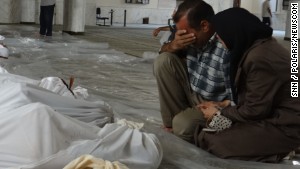
A Syrian man mourns over the bodies of those killed in an alleged chemical weapons attack in Damascus, Syria, in 2013.
In the second alleged incident, the Syrian government claimed that "terrorist groups" carried out a gas attack that killed five people in the old town of the besieged city of Aleppo on Tuesday afternoon, according to the state-run news agency SANA.
"Five civilians were killed and eight others suffered suffocation due to a terrorist attack with shells containing poisonous gas," the city's health director Mohamad Hazouri told SANA, which reported two others were killed and 17 others injured in separate terrorist attacks in the city Tuesday.
Aleppo is about 50 kilometers (31 miles) northeast of Saraqeb.
Reports of the alleged chemical attacks came as a CNN stringer in rebel-held eastern Aleppo said intense airstrikes and artillery assaults were underway in the area, the fiercest bombardment in the five years of the conflict, he said.
The assault was a counteroffensive from Syrian regime forces and their Russian allies after advances by rebel forces pushing to break the government siege that has been choking their territory.
The city's eastern neighborhoods were encircled by government troops last week, cutting off all supply lines.
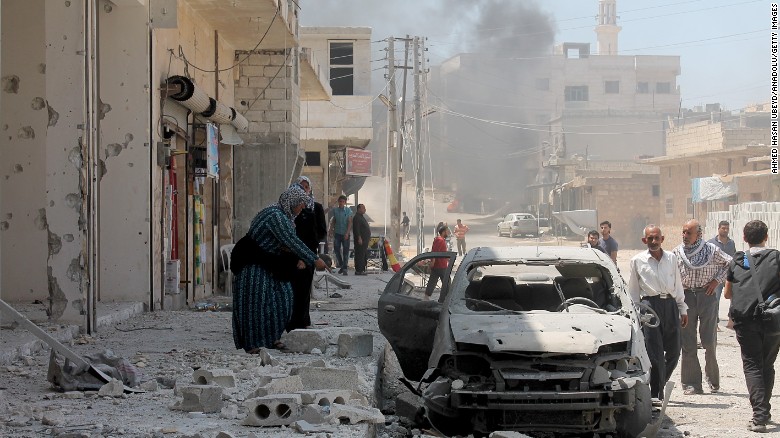
A woman inspects a damaged car after Russian planes carried out an airstrike over Etarib district of Aleppo, Syria.
Aleppo: Syria's troubled city explained in numbers
Doctor: Symptoms of chlorine poisoning
In the Saraqeb attack, the gas, which the statement said smelled like chlorine, caused 30 cases of breathing difficulties, said the Idlib Civil Defence, also known as the White Helmets.
CNN has spoken with a doctor in Saraqeb who said he treated some of those affected by the alleged attack. He said their symptoms were consistent with those "of someone who has suffered from chlorine poisoning."
Syria's cessation of hostilities, explained
A photographer who took photos of the injured for the White Helmets said victims were suffering symptoms such as watering eyes, spasms, sweating, coughing and difficulty breathing.
The Syrian National Council, a coalition of opposition groups, blamed the Assad regime for the alleged attack in Idlib province, where a Russian helicopter had earlier been downed after making what the Kremlin said was an aid delivery to Aleppo.
"Developments on the ground show how the Assad regime continues to blatantly ignore international law and U.N. Security Council resolutions, especially those related to the use of chemical weapons," the Syrian National Council said.
Alleged attack comes after helicopter downed
The downing of the Russian helicopter Monday was the biggest single loss of life for Syria's key military backer since its warplanes started carrying out airstrikes in September 2015.

Russia says helicopter shot down after delivering aid
No one has claimed responsibility for the downing of the Mi-8 aircraft.
Members of Jabhat Fateh Al-Sham have a strong presence in Idlib province, as do other rebel groups fighting against the Syrian regime. Jabhat Fateh Al-Sham, formerly called al Nusra Front, recently severed its ties to al Qaeda.
5 dead as Russian helicopter shot down in Syria
30 dead in rebel shelling
Aleppo is in the midst of a humanitarian crisis, as the eastern rebel-held part of the city has come under siege by government forces.
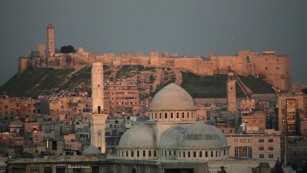
Aleppo: Then and now
The siege has essentially cut the area off from vital supplies, and has left the city without enough food, water, medical supplies, and fuel to keep ambulances and hospital generators running.
At least 30 people, including children and women, were killed in government-controlled areas of southwestern Aleppo in recent shelling by rebel forces, the Syrian Observatory for Human Rights said Tuesday.
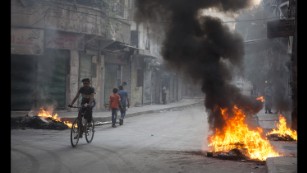
Residents burned tires and other materials to start fires in eastern Aleppo, to obscure the vision of pilots looking to drop bombs on neighborhoods.
Aleppo surrounded: Why developments are so significant
The shells were fired from within rebel-held eastern Aleppo, targeting surrounding areas controlled by the Syrian regime, the UK-based monitoring group said.
Eastern Aleppo has been held by rebel groups since July 2012.
Fires to stop the bombs
Some neighborhoods in eastern Aleppo have been under fire for more than 80 consecutive days, with regular bombardment by regime forces backed by Russian air power.
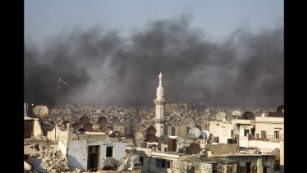
A thick smogs hangs over Aleppo as residents light fires to prevent pilots from bombing their homes.
At least 6,000 people have been either killed or injured in that time, according to the Syrian Observatory for Human Rights.
The group said rebel-held areas in the city's east have faced sustained attack by regime artillery and airstrikes, while rebel and Islamic factions have shelled regime-controlled areas in western neighborhoods.
Images from eastern Aleppo show residents, including children, lighting fires to obscure the vision of pilots and to prevent them from dropping bombs on neighborhoods.
Hundreds of thousands trapped
The United Nations has warned of a potential humanitarian catastrophe as regime troops backed by Russian air power tighten their grip on the ruined city. It estimates that between 200,000 and 300,000 people remain trapped in the besieged eastern part of Aleppo.
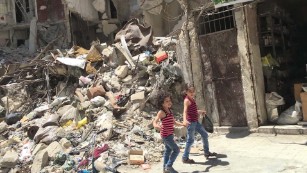
Humanitarian disaster feared for what is left of Aleppo
For those left in the area, life is grim.
The siege has essentially strangled eastern Aleppo, where the shelves of once-bustling food markets are empty and people are reusing medical supplies that should be disposable, such as syringes, CNN correspondent Ian Lee reports.
Escape routes
The Syrian and Russian governments say three humanitarian corridors have been opened to allow for the distribution of badly needed food and medical aid to civilians and to provide residents -- along with rebels who choose to surrender -- the opportunity to leave. The Syrian regime and Russia say four more corridors will soon be made available.
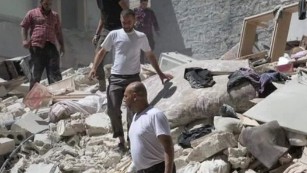
Syria, Russia announce humanitarian corridors
The Russian military said 169 civilians and 69 militants fled through the corridors over the weekend, the state-run Russian news agency Sputnik reported, while Syria's state news agency SANA says families and surrendering militants have continued to flee the rebel neighborhoods.
But CNN sources on the ground say the corridors are barely being used as an escape route.
They say they believe people are too scared to flee, fearing what the regime might do to them once they get out.
U.S. Secretary of State John Kerry suggested Friday that the corridor approach could potentially be a "ruse."
Russia says it has prepared 14 tons of humanitarian cargo for those who leave the city, with 2.5 tons of food and other essentials already supplied.
News Courtesy: www.cnn.com

